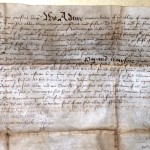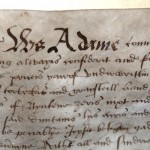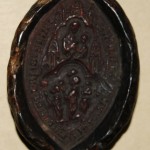This deed recording a transaction relating to property in Torbrex near Stirling is unusual for a number of reasons. First, it relates to a time of great change in Scottish history, the time of the Reformation when the great monastic houses were being dismantled and their riches appropriated by the Crown and distributed to secular landowners. Secondly, it is written in the Scots vernacular, the language that people would have spoken on a day to day basis. Thirdly, it has attached to it a very fine example of the formal seal of Cambuskenneth Abbey and there are few such good examples of this remaining to us because of what was happening in the mid 16th century.
Cambuskenneth Abbey was founded by order of King David I, around 1140 and dedicated to the Virgin Mary. It was originally known as the Abbey of St Mary of Stirling or sometimes simply Stirling Abbey. It was run by Canons of the Augustinian Order. This was a prestigious foundation largely owing to its proximity to the Royal Burgh and Castle. Kings prayed there including Edward I ‘Longshanks’ of England. Robert Bruce held his first parliament after the Battle of Bannockburn there and both James III and his Queen Margaret of Denmark had their tombs within its precincts.
The Abbey was endowed with extensive property in the Stirling area that was farmed by tenants to provide an income for the establishment, and the Abbot would have had status similar to any other feudal superior of a large landed estate. Originally, the Abbot would have overseen the day-to-day administration of these estates but by 1559, the Abbey had been effectively abandoned and few monks remained there. The estates were forfeited to the Crown and a lay administrator or Commendator was appointed by the Queen to carry on the business of the estate. The running of Cambuskenneth Abbey was passed to John Erskine, Governor of Stirling Castle who in turn appointed his nephew, Adam Erskine, Commendator.
The document itself is a lease for 19 years of the right to collect the ‘teind schavis’ or tithe sheaves of property at Torbrex and Greysteel near Stirling. This right to take the income that would originally have come to the Abbey is granted in the customary legal language of the time to one Duncan Nairn, described as ‘ane honourable man’. Duncan is to profit from the ‘tithe’ or tenth of the crop originally intended to support the monastic establishment. In this case the total owed is three bolls of meal or oatmeal and one boll three furlots of ‘beir’, that is barley. There is also the option of paying the cash equivalent which was 13 shillings and fourpence for each boll of meal or barley. The language of the document is Scots. The Scots used their own language in legal documents earlier than any other people in Europe, the first examples dating from the later 14th century. This document gives a good example of legal Scots in its description of the property and terms of the agreement.
The lozenge-shaped vesica seal was used by ecclesiastical bodies to distinguish them from those used by secular authorities. The example appended to this document is in particularly good condition. The seal was used from the earliest times to indicate the authenticity of a document with the sign manual or signature being used from the middle of the 15th century. Both are given on this document.
This lease is a wonderful example of legal pragmatism in a time of change. The Commendator passes on the right to levy a religious tax to a lay landowner, using the original seal of the then defunct establishment to ratify the agreement. Despite the turmoil in the world of faith, practical solutions for the making of a profit on land continued to be found.


